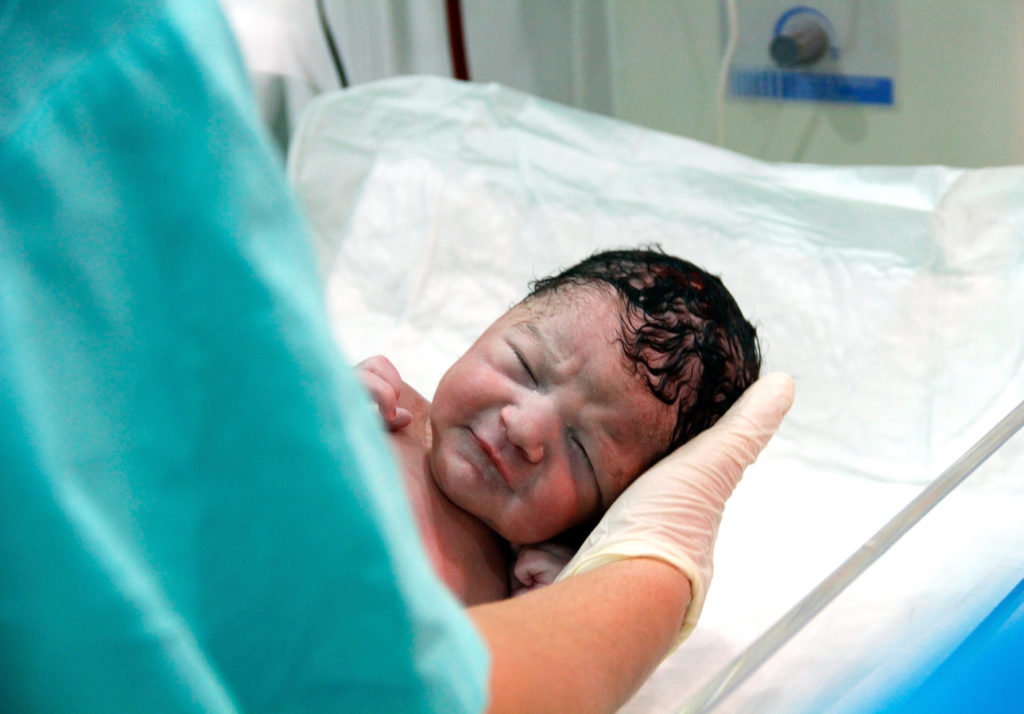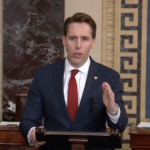This essay is one of the editor’s picks on abortion and infanticide. Read related articles here.
As medical professional organizations and individuals representing over 30,000 physicians who practice according to the Hippocratic Oath, we write in support of S. 311, the Born-Alive Abortion Survivors Protection Act.
Medical facts are important.
Fact 1: It is an undisputed scientific fact that a distinct, living human being exists in the womb of a pregnant mother.
From the moment of fertilization, a human being meets all of the scientific criteria for a living organism [1] and is completely distinct from her/his mother, not a part of her/his mother’s body. This is scientific fact. It is therefore scientifically correct for S. 311 to identify the living survivors of abortions as human persons and afford those human beings the full protection of the law in the same way that infants of similar gestational ages are currently protected.
Start your day with Public Discourse
Sign up and get our daily essays sent straight to your inbox.Fact 2: Abortion is not healthcare, much less an essential part of women’s health care, and abortions in the third trimester are not done to save a woman’s life. [2]
The fact that over 85 percent of OB-GYNs in a representative national survey do not perform abortions on their patients [3] is glaring evidence that abortion is not an essential part of women’s healthcare. The vast majority of abortions are done by abortion providers who do not provide any other kind of medical care for the woman. Abortion treats no disease. Pregnancy is not a disease, and deliberately killing the unborn child by abortion is not healthcare.
It is clear from testimony by abortion practitioners during the Partial Birth Abortion Ban hearings [4] that, unlike a delivery, which separates the mother and her fetus for the purpose of life, an abortion separates the mother and the fetus with the purpose of guaranteeing that the baby is born dead. That’s why a fetus who survives an abortion is called a “failed abortion.” The separation did not fail to occur. What “failed” to occur in a “failed abortion” is the guarantee of a dead baby.
There are rare circumstances in which a mother’s life is in jeopardy due to either pre-existing conditions or pregnancy complications. It is extremely rare for this to occur prior to the point of viability (currently 22 weeks after last menstrual period, 20 weeks after fertilization). After 20 weeks fertilization age, it is never necessary to intentionally kill the fetal human being in order to save a woman’s life. [5] In cases where the mother’s life actually is in danger in the latter half of pregnancy, there is not time for an abortion, because an abortion typically is a two to three-day process. Instead, immediate delivery is needed in these situations, and can be done in a medically appropriate way (labor induction or C-section) by the woman’s own physician. We can, and do, save the life of the mother through delivery of an intact infant in a hospital where both the mother and her newborn can receive the care that they need. There is no medical reason to intentionally kill that fetal human being through an inhumane abortion procedure, e.g. dismembering a living human being capable of feeling pain [6] [7] [8], or saline induction which burns off the skin, or feticide with subsequent induction.
In cases where the mother’s life actually is in danger in the latter half of pregnancy, there is not time for an abortion... We can, and do, save the life of the mother through delivery of an intact infant in a hospital where both the mother and her newborn can receive the care that they need. There is no medical reason to intentionally kill that fetal human being.
Obstetricians who abide by the Hippocratic oath strive, to the best of our ability, to save both lives when at all possible. There are two patients under our care. We never intentionally target the unborn child during the separation procedure in order to guarantee that the baby is born dead.
Fact 3: No matter the circumstances of their birth, infants who are born alive must be given appropriate medical care.
Any infant who is born alive, at any stage of development, is a person entitled to the protections of the law and appropriate care as a new patient. There is no scientific or legal reason to distinguish between human beings born after an attempted abortion and human beings born after attempted live birth. A distressed newborn should get immediate emergency care and a professional evaluation to determine appropriate steps to promote his/her health and well-being. Obviously, a distressed newly born baby presents for emergency medical care at the moment of her or his birth, regardless of whether that birth results from an abortion attempt or attempted live delivery. EMTALA mandates hospitals to examine and treat any person who presents for emergency medical care.
There is no scientific or legal reason to distinguish between human beings born after an attempted abortion and human beings born after attempted live birth.
These same principles apply in cases in which the human being in utero has a disability or has been given a life-limiting diagnosis, such as anencephaly. Human beings who are disabled at birth deserve the same respect and dignity afforded to able-bodied children at similar gestational ages. The terms “incompatible with life” or “fatal fetal malformations” are not medical terms. For many children with medical conditions previously labelled as such, survival for years has been accomplished [9], and is very possible when supportive care is provided.
Additionally, health care professionals are notoriously poor predictors of whether infants will live or die when supportive medical care is offered. [10] If a fetus has a potentially life-limiting diagnosis which is expected to result in death shortly after birth, families should be presented with the potential benefits of medical care and, accepting that such care might only prolong an inevitable death, be offered perinatal hospice. [11] [12]
Perinatal hospice respects the human dignity of the newborn and allows the family to hold and care for their child after birth, celebrating the precious time they have together as well as allowing them to grieve the brevity of this same gift. Perinatal hospice provides optimal care for the mother, honors the life of her child and allows the family the opportunity to acknowledge, love, and mourn its newest member. Literature comparing outcomes of delivery and perinatal hospice care with abortion in cases of anencephaly reveals significantly better mental health outcomes for mothers who do not abort. [13] [14] [15] Perinatal hospice is compassionate and comprehensive health care for women whose fetuses have life-limiting diagnoses.
S.311 provides a scientifically sound, medically accurate, and respectful approach to ensure that the innocent human being who survives an attempted abortion will be treated with the same human dignity and respect that similarly aged human beings receive in the course of good neonatal medical care. S. 311 ensures that human beings with disabilities are not targeted for intentional killing at the moment of birth.
For all of these above reasons, we, the undersigned medical organizations and individuals, strongly urge you to pass S. 311.
Respectfully submitted,
Donna J. Harrison, M.D., Executive Director
American Association of Pro-Life Obstetricians and Gynecologists [16]
Michelle Cretella, M.D., Executive Director
American College of Pediatricians [17]
John Schirger, M.D., President,
Catholic Medical Association [18]
David Stevens, M.D., CEO
Christian Medical & Dental Associations [19]
Jane Orient, M.D., Executive Director
Association of American Physicians and Surgeons [20]
Sources:
[1] Condic M, “When Does Human Life Begin? The Scientific Evidence and Terminology Revisited,” University of St. Thomas Journal of Law and Public Policy 8(1) Fall 2013 Article 4.
[2] Greene-Foster D and Kimpart K, “Who Seeks Abortions at or After 20 Weeks?” Perspectives on Sexual and Reproductive Health 2013 45(4):210-218 doi:10.1363/4521013.
[3] Stulberg D, Dude A, Dahlquist B, Curlin F., “Abortion Provision Among Practicing Obstetrician-Gynecologists.” Obstet Gynecol. 2011 September ; 118(3): 609–614. doi:10.1097/AOG.0b013e31822ad973.
[4] Gonzales v Carhart. At page 9:
“Yet one doctor would not allow delivery of a live fetus younger than 24 weeks because ‘the objective of [his] procedure is to perform an abortion,’ not a birth…. The doctor thus answered in the affirmative when asked whether he would ‘hold the fetus’ head on the internal side of the [cervix] in order to collapse the skull’ and kill the fetus before it is born…. Another doctor testified he crushes a fetus’ skull not only to reduce its size but also to ensure the fetus is dead before it is removed.”
See also page 11:
“(b) As used in this section—
“(1) the term ‘partial-birth abortion’ means an abortion in which the person performing the abortion—
“(A) deliberately and intentionally vaginally delivers a living fetus until, in the case of a head-first presentation, the entire fetal head is outside the body of the mother, or, in the case of breech presentation, any part of the fetal trunk past the navel is outside the body of the mother, for the purpose of performing an overt act that the person knows will kill the partially delivered living fetus; and
“(B) performs the overt act, other than completion of delivery, that kills the partially delivered living fetus;…” [Emphasis added.]
[5] Dublin Declaration on Maternal Health.
“As experienced practitioners and researchers in obstetrics and gynaecology, we affirm that direct abortion – the purposeful destruction of the unborn child – is not medically necessary to save the life of a woman.
We uphold that there is a fundamental difference between abortion, and necessary medical treatments that are carried out to save the life of the mother, even if such treatment results in the loss of life of her unborn child.
We confirm that the prohibition of abortion does not affect, in any way, the availability of optimal care to pregnant women.”
[6] Testimony of Dr. Maureen Condic. District of Columbia H R.179J, 23 May 2013. Pages 36-46.
[7] American Association of Pro-Life Obstetricians and Gynecologists.Practice Bulletin 2: Fetal Pain.
[8] American Association of Pro-Life Obstetricians and Gynecologists. Fetal Pain Fact Sheet.
[9] Wilkinson DJ, Thiele P, Watkins A, De Crespigny L, “Fatally flawed? A review and ethical analysis of lethal congenital malformations.” BJOG. 2012 Oct; 119(11): 1302-8. doi: 10.1111/j.1471-0528.2012.03450.x. Epub 2012 Jul 25.
[10] Meadow W, et al. “Just, in time: ethical implications of serial predictions of death and morbidity for ventilated premature infants.” Pediatrics. 2008 Apr; 121(4): 732-40.
[11] Perinatal Hospice and Palliative Care.
[12] American Association of Pro-Life Obstetricians and Gynecologists. Practice Bulletin 1: Perinatal Hospice.
[13] Cope H, Garrett ME, Gregory S, Ashley-Koch A, “Pregnancy continuation and organizational religious activity following prenatal diagnosis of a lethal fetal defect are associated with improved psychological outcome.” Prenat Diagn. 2015 Aug; 35(8): 761-768.
[14] Calhoun BC, Reitman JS, Hoeldtke NJ. “Perinatal Hospice: A Response to Partial Birth Abortion for Infants with Congenital Defects.” Issues in Law and Medicine 1997; 13(2): 125-143.
[15] Calhoun BC, Hoeldtke NJ, Hinson RM, Judge KM. “Perinatal Hospice: Should all centers have this service?” Neonatal Network 1997; 16(6): 101-102.
[16] The American Association of Pro-Life Obstetricians and Gynecologists is a 4,600-member organization consisting of OB-GYNs and other physicians and medical professionals who work in the field of reproductive health, and who practice according to the Hippocratic Oath. The mission of AAPLOG is to provide an evidence-based defense of both our pregnant patient and her unborn child.
[17] The American College of Pediatricians is a Hippocratic medical organization dedicated to using the best available science to promote the optimal health of all children from their conception until natural death.
[18] The Catholic Medical Association is a national, physician-led community of over 2,300 healthcare professionals consisting of 109 local guilds. CMA mission is to inform, organize, and inspire its members, in steadfast fidelity to the teachings of the Catholic Church, to uphold the principles of the Catholic faith in the science and practice of medicine.
[19]The Christian Medical and Dental Associations is a 19,000+ member organization in the United States, consisting of healthcare professionals from multiple disciplines including medicine, dentistry, physician assistants, nurse practitioners, physiotherapists, optometrists, pharmacists, and many others. The mission of CMDA is to motivate, educate, and equip Christian healthcare professionals to glorify God by serving with professional excellence as witnesses of Christ love and compassion to all peoples and by advancing biblical principles of healthcare within the church and to our culture.
[20] AAPS was founded in 1943 to preserve and promote the practice of private medicine. It upholds the sanctity of the patient-physician relationship and the ethical principles in the Oath of Hippocrates.











